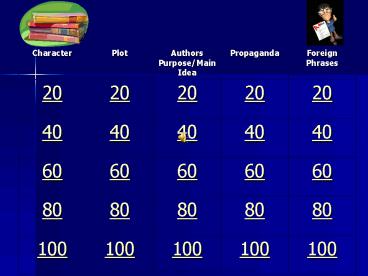8th Grade Jeopardy - PowerPoint PPT Presentation
1 / 51
Title:
8th Grade Jeopardy
Description:
The ways in which a writer reveals the personality of a character. ... BANDWAGON. the celebrity endorsement of a philosophy, movement or candidate. ... – PowerPoint PPT presentation
Number of Views:794
Avg rating:3.0/5.0
Title: 8th Grade Jeopardy
1
8th Grade Jeopardy
Compliments of the James Madison Center, JMU
2
A person in a story, a play, or other literary
work. May also be an animal, a thing, or a
natural force such as a flood or blizzard.
3
- Character
4
The ways in which a writer reveals the
personality of a character. Writers reveal
characters in two different ways direct
characterization and indirect characterization
5
- Characterization
6
A method in which the writer tells
readers directly what a character is like.
Example Teddy was the smartest person I ever
knew.
7
- Direct Characterization
8
A method in which the writer shows what a
character is like and lets readers draw their own
conclusions. There are five basic ways that a
writer can show characterization indirectly
Describing the characters appearance Showing
the character in action Allowing us to hear the
characters words Revealing the characters
thoughts and feelings Showing how others react
to the character
9
- Indirect Characterization
10
The reasons a character behaves in a certain way.
A characters motives may arise from feelings,
experiences, or others actions
11
- Motivation
12
What happens in a story, novel, play, or
narrative poem. It is the chain of related events
that makes up a story
13
- Plot
14
A struggle between characters or between opposing
forces. An external conflict takes place between
two characters, between a character and a group,
or between a character and something elsesuch as
a monster or a sandstorm. An internal conflict
takes place within a characters mind or heart. A
story may have more than one
15
- Conflict
16
Hints or clues that suggest what will happen
later in a story. Helps to build suspense.
17
- Foreshadowing
18
The part of the story in which remaining
questions are answered and loose ends of the plot
are tied up. The resolution usually comes at the
end of the story.
19
- Resolution
20
The most exciting or suspenseful part of a story.
Something happens that reveals how the conflict
will turn out.
21
- Climax
22
The main reason he or she has for writing. The
three basic purposes are to inform, to persuade,
and to entertain.
23
- Authors Purpose
24
Professor Howard Gardner believes that people are
smart in different ways. In his studies, he found
many different kinds of intelligence. For
example, some people have interpersonal
intelligence. This means that they work well with
others. They are also good at sensing
other peoples feelings. Counselors and
teachers have this kind of intelligence.
25
- The author wrote this mostly to inform the reader
that people can be smart in many different ways.
26
The writers most important point. What the
paragraph mostly about
27
- Main Idea
28
In school, kids used to call Michael Jordan
baldhead because of his short hair. They would
rub his head and call him names. Although he
loved basketball, he had to work hard on
his skills. His brother often won the games they
played in their backyard basketball court. In the
tenth grade, Jordan tried out for varsity
basketball but didnt make the cut. This
beginning was definitely not an indication of
things to come.
29
- Main Idea
- Michael Jordan struggled early
- in life and didnt start out being
- one of the best players.
30
an educated guess, about something the writer
doesnt say or explain.
31
- Making Inferences
32
information that is spread for a purpose of
promoting some cause.
33
- Propaganda
34
idea that everyone is doing this, or everyone
supports this person/cause, so should you.
35
- BANDWAGON
36
the celebrity endorsement of a philosophy,
movement or candidate. In advertising, for
example, athletes are often paid millions of
dollars to promote sports shoes, equipment and
fast food.
37
- TESTIMONIAL
38
grassroots and all-American. the candidate or
cause is identified with common people from
everyday walks of life.
39
- PLAIN FOLKS
40
the candidate/speaker attempts to persuade us
through the indirect use of something we respect,
such as a patriotic or religious image, to
promote his/her ideas
41
- TRANSFER
42
unconditional authorityOrigin French. Direct
Translation White card
43
- carte blanch
44
- the illusion of having previously experienced
something actually being encountered for the
first time. - disagreeable familiarity or samenessOrigin
French. - Direct Translation to have seen before
45
- déja vu
46
1. the theory or system of government that
upholds the autonomous character of the economic
order, believing that government should intervene
as little as possible in the direction of
economic affairs.2. the practice or doctrine of
noninterference in the affairs of others,esp.
with reference to individual conduct or freedom
of action.Origin French. Direct Translation
Allow to act
47
- laissez-faire
48
an accomplished fact a thing already doneThe
enemy's defeat was a fait accompli long before
the formal surrender.Origin French. Direct
Translation Already done
49
- fait acompli
50
1. an exceptional achievement by an artist,
author, or the like, that is unlikely to be
equaled by that person or anyone else stroke of
geniusHerman Melville's Moby Dick was a tour de
force.2. a particularly adroit maneuver or
technique in handling a difficult situationThe
way the president got his bill through the Senate
was a tour de force.3. a feat requiring unusual
strength, skill, or ingenuity.Origin French.
Direct Translation Tower of force
51
- tour de force

